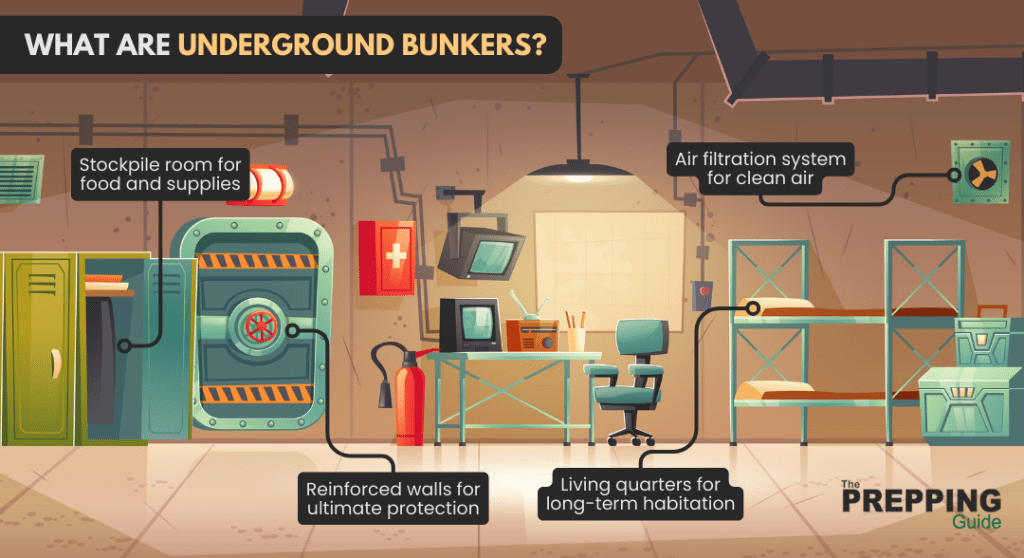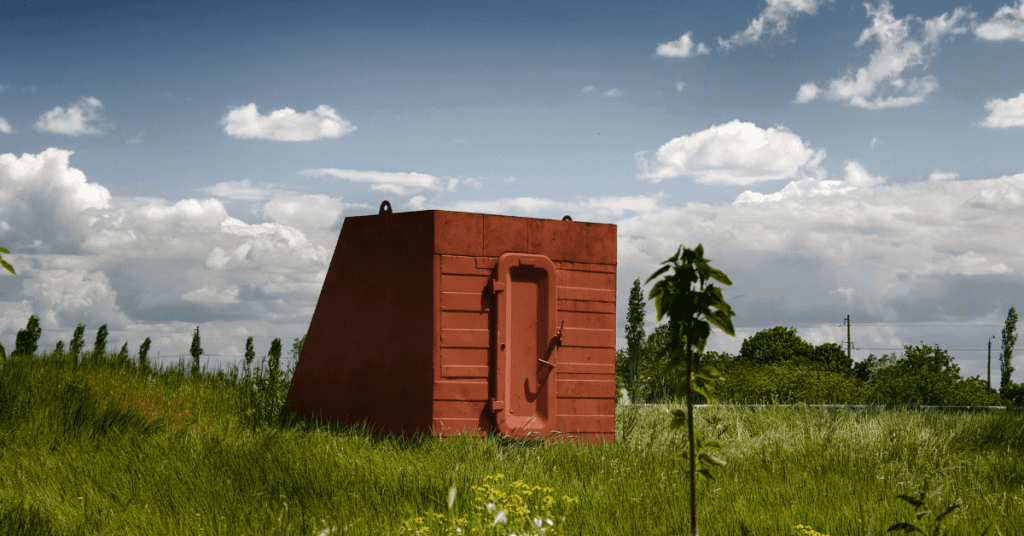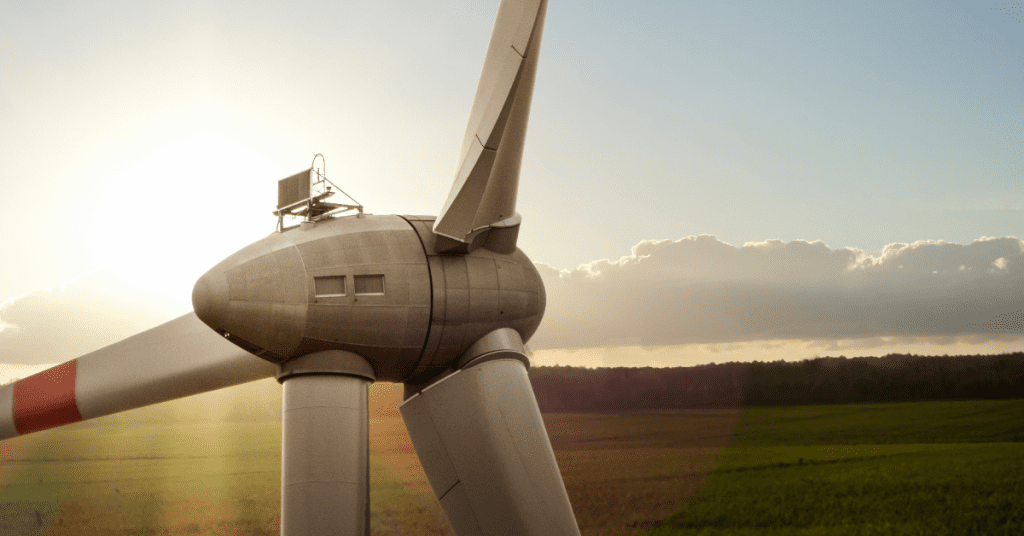Underground bunkers offer a unique combination of discretion, protection, and long-term sustainability. In today’s unpredictable world, having a safe and secure retreat is more important than ever. As the demand for secure and sustainable living solutions rises, finding the perfect underground bunker for sale has never been more crucial.
Key Takeaways
- Underground bunkers offer security and preparedness in an unpredictable world. They go beyond disaster shelters, providing a safe haven for various threats.
- The market features a wide variety of bunkers, from historic missile silos to modern luxury shelters. Options range from DIY kits to pre-built community bunkers.
- Choosing the right bunker requires careful consideration of several factors. Location, size, amenities, legal aspects, and budget are all crucial for a well-suited investment.
- Costs can vary significantly depending on size, materials, and features. Basic options start around $10,000, while luxury bunkers can reach hundreds of thousands.
- Vetting sellers is crucial. Look for certifications, research seller reputation, and schedule inspections. Ensure the bunker meets building codes and your safety needs.
This guide explores the essentials of underground bunkers, from types and features to buying tips and maintenance. Discover how these hidden fortresses can enhance safety and preparedness for any situation.
Understanding Underground Bunkers
Underground bunkers are secure, fortified structures built below ground to provide protection against various threats, such as natural disasters, nuclear fallout, or military attacks. They are designed to ensure the safety and survival of occupants during emergencies.

Types of Underground Bunkers
Underground bunkers come in many shapes and sizes, designed for various purposes. Here are some of the most common types:
Fallout Shelters: These bunkers are designed to protect occupants from radioactive fallout in the event of a nuclear war. They are typically made of concrete or steel and have thick walls, air filtration systems, and sealed doors.
Blast Shelters: Blast shelters are designed to protect occupants from the shockwave and debris from an explosion. They are typically smaller than fallout shelters and may not have the same level of filtration or long-term supplies.
Storm Shelters: Storm shelters are designed to protect occupants from tornadoes, hurricanes, and other severe weather events. They are typically built underground or in basements and may have features like reinforced walls and roofs.
Military Bunkers: Military bunkers are used by soldiers for protection during wartime. They can be located above ground or underground and may be very elaborate, with features like sleeping quarters, storage areas, and command centers.
Civilian Shelters: Civilian shelters are designed to protect civilians from a variety of threats, such as war, terrorism, or natural disasters. They may be located in public buildings, schools, or workplaces.
List of Underground Bunkers for Sale
Exploring the market for bunkers in the United States reveals a fascinating array of properties, from historic missile silos to modern luxury shelters. These bunkers offer unique opportunities for secure living, investment, or recreational use. Below is a curated list of 15 bunkers currently available for sale, highlighting their distinctive features and locations.
1. Atlas E Missile Base, Sprague, WA
This property is a former Atlas E missile silo, offering over 19,172 square feet of space. Built during the Cold War, it was designed to withstand significant impacts, making it incredibly robust. The base can be transformed into a unique home, event space, or secure underground haven. It features unparalleled security and privacy, with options for architectural creativity. Located near Spokane, it combines rural tranquility with access to urban amenities.
Price: $1,450,000
Location: Near Spokane, WA
2. Revamped Missile Complex, York, NE
This decommissioned Atlas-F missile silo has been renovated to include modern amenities such as a new kitchen and bathroom, and updated electrical systems. The property features a 1,256 sq ft underground residence, with a first-floor launch control center and an unfinished lower level. Originally built to withstand nuclear attacks, it offers a unique combination of historical significance and modern comfort.
Price: $750,000
Location: York, NE
3. Bomb Shelter 8×12 Mini Bunker
This compact and sturdy 8×12 mini bunker from Rising Bunkers offers a secure, underground hideout with air filtration systems, NBC (nuclear, biological, chemical) protection, and blast doors. Its small footprint makes it an ideal choice for quick and efficient setups, perfect for small families or individual preppers looking for immediate, reliable refuge.
Price: $50,900
Location: Murchison, TX
4. Cold War Bunker Mansion, MO
This property is a repurposed Cold War-era bunker, now featuring amenities such as a gym, soundproof music studio, theater room, and a glass-blowing studio. It has 16-foot high ceilings in the recreation area, providing ample space for various activities. Originally part of the AT&T L-Carrier Cable Network, it boasts blast doors and EMP shielding, making it a secure and versatile property.
5. Former Army Base Units, SD
Located in Edgemont, SD, these converted army base units retain their robust military-grade construction, offering exceptional security with reinforced structures. The properties come with expansive underground storage facilities, ideal for stockpiling supplies and equipment. This is an excellent option for those seeking a fortified residence with ample space for large-scale preparedness.
Price: $69,900
Location: Edgemont, SD
6. Vivos xPoint Bunker, SD
Vivos xPoint offers shared underground community bunkers designed to withstand all doomsday scenarios. Each bunker is equipped with essentials such as food, medical supplies, filtration systems, and geothermal heating and cooling. The community is set up for modern comfort while providing maximum security, making it ideal for preppers and survivalists.
Price: Starting at $35,000 per person
Location: South Dakota
7. Rolling Hills Missile Silo, Central Kansas
This renovated Atlas missile silo is listed for $1.3 million and features a two-story command center and a silo 182 feet deep. The property includes blast doors, thick reinforced concrete, and is designed to withstand extreme conditions, offering endless possibilities for secure living or business ventures.
Price: $1,300,000
Location: Central Kansas
8. Vivos Indiana
Vivos Indiana is a luxury underground survival community designed to withstand all doomsday scenarios. The facility includes private suites equipped with modern amenities such as a year’s supply of food, medical supplies, filtration systems, and geothermal heating. It offers the security and comfort of a high-end hotel, making it ideal for couples or families.
Price: $35,000 per person
Location: Indiana
9. DIY Bomb Shelter
The DIY Bomb Shelter Kit from American Safe Room provides all necessary components to build a custom underground shelter. The kit includes ventilation systems, blast doors, and filtration systems designed to protect against nuclear, biological, and chemical threats. It is ideal for individuals looking to create a secure underground space tailored to their needs.
Price: $750,000
Location: Available for delivery across the US
10. Precast Concrete Shelter
Atlas Survival Shelters offers precast concrete shelters designed for quick installation and maximum security. These shelters are built to withstand severe natural disasters and nuclear fallout, providing a safe and durable underground space. They come with features like NBC air filtration, blast doors, and optional interior customization.
Price: Starting at $49,900
Location: Available for delivery and installation across the US
11. Hardened Shelter, Virginia Beach, VA
Specializing in custom-built shelters, this company offers a range of options designed for various threats. The properties are built to provide maximum security, with advanced features for blast hardening and threat mitigation.
Price: Contact for pricing
Location: Throughout the US
12. Underground Prepper Bunker, MO
Designed for ultimate resilience, this underground bunker is fully equipped with state-of-the-art survival features including long-term food storage solutions, energy generation systems, and water purification facilities. Its concealed entrance ensures privacy and security, making it a top choice for preppers prioritizing invisibility and self-sufficiency in unpredictable scenarios.
Price: $284,900
Location: Mountain Grove, MO
13. BombNado
The BombNado is a compact, in-ground tornado and bomb shelter designed to be installed beneath garages or outdoor areas. It features a reinforced steel structure, NBC filtration system, and blast doors, making it an effective and discreet solution for emergency preparedness.
Price: $18,999
Location: Available for installation across the US
14. Self-sufficient Shelter, AR
This property on 26 acres offers a comprehensive survival setup with its off-grid capabilities, including solar power installations and rainwater harvesting systems. The land provides ample room for agriculture and livestock, ensuring food security. The shelter itself is built to withstand severe conditions, offering a sustainable living solution for those planning to live independently from societal infrastructures.
Price: $379,000
Location: Valley Springs, AR
15. U.S. Safe Room® Underground Bunker
U.S. Safe Room® offers a customizable underground bunker that provides high-level protection against various threats, including nuclear fallout and natural disasters. The bunker features heavy-duty construction, NBC air filtration, and can be tailored with amenities like sleeping quarters, kitchens, and bathrooms.
Price: Varies by size and configuration
Location: Available for delivery and installation across the US
Why Do You Need An Underground Bunker?

In an unpredictable world, having an underground bunker can provide a sense of security and preparedness that’s hard to match. These structures are not just about surviving extreme scenarios; they offer peace of mind and a safe space for you and your loved ones.
Underground bunkers are packed with features designed to enhance security and safety. Here are some of them:
- Blast Doors: These are specially designed to withstand significant pressure and prevent entry by unauthorized individuals, providing a crucial line of defense in high-risk situations.
- Air Filtration Systems: Advanced air filtration systems are essential for maintaining breathable air inside the bunker, protecting against chemical, biological, and radiological contaminants.
- Reinforced Walls: Built to withstand extreme forces, reinforced walls are crucial for ensuring the structural integrity of the bunker, keeping occupants safe from external impacts.
- Emergency Exits: Having multiple exits is a critical safety feature, ensuring that occupants can evacuate safely if the primary entrance is compromised.
- Surveillance Systems: Integrated cameras and motion sensors enhance security by monitoring the surroundings and alerting occupants to potential threats.
Choosing the Right Bunker: What to Consider
Choosing the ideal underground bunker is a significant decision that requires careful thought. Here’s what you need to consider to ensure your bunker meets your needs for safety, comfort, and functionality.
Location and Accessibility

The location of your bunker should strike a balance between being close enough for quick access during emergencies and discreet enough to remain undetected. Evaluate the proximity to essential services and ensure it is accessible all year, despite potential seasonal challenges.
The entrance should be straightforward to reach yet discreet, possibly camouflaged or integrated into existing structures like garages or sheds to enhance security.
Size and Amenities
Select a bunker size that accommodates your family comfortably without being overly complex or expensive. For a family of four, consider the space and resources required for extended stays.
Focus on essential amenities that promote comfort and independence. These include sleeping areas, a kitchen, and bathroom facilities.
Depending on your needs, you might also want to include storage areas for food and supplies, power generation systems like solar panels, and water purification systems.
Legal and Zoning Issues
Understanding the legalities of owning and constructing a bunker is essential to avoid potential complications down the line. Before you start digging, it’s crucial to check local building codes and zoning laws.
These regulations can vary significantly depending on your location and might include restrictions on the depth, size, and placement of underground structures. Consulting with local authorities or a legal expert can provide clarity and ensure your bunker complies with all relevant laws.
Additionally, consider any permits that might be required for construction. Some areas might have specific requirements for structures designed to serve as emergency shelters, including safety inspections and structural assessments. It’s also wise to inform your insurance provider about your plans, as this can impact your property insurance policies.

Here are other factors to consider:
High-Quality Construction Materials: Ensure the bunker is made from robust materials such as reinforced concrete or steel, which offer excellent protection against blasts, impacts, and natural disasters.
Advanced Security Features: Look for bunkers equipped with advanced security features like blast doors, which can withstand significant pressure, and reinforced walls that provide additional protection. Surveillance systems, including cameras and motion detectors, can enhance security by monitoring the surroundings and alerting occupants to potential threats.
Warranty and Support: Opt for bunkers that come with a comprehensive warranty, covering structural integrity and essential systems for a specified period. Additionally, ensure the manufacturer offers ongoing support and maintenance services, which can be invaluable for addressing any issues that may arise after installation.
Energy Independence: Consider bunkers that include renewable energy sources like solar panels or wind turbines, providing a sustainable and reliable power supply. This feature is particularly important in scenarios where traditional power sources may be unavailable or disrupted.

Cost and Financing Options
The cost of underground bunkers varies significantly based on size, materials, and included features. Basic bunkers, providing essential protection with minimal amenities, typically start between $10,000 and $20,000. These entry-level units are compact and simple yet secure.
For those considering building a bunker from scratch, costs can range from $40,000 for a modest setup to over $500,000 for high-end designs that include multiple rooms, advanced security systems, and sustainable features like renewable energy sources. This range accounts for the raw materials, labor, design, and any specialized equipment needed.
Luxury bunkers, featuring extensive amenities such as reinforced structures, sophisticated air filtration systems, and luxurious living spaces, can escalate to several hundred thousand dollars.
It’s crucial to consider not only the initial investment but also ongoing expenses such as maintenance, upgrades, and utilities. Many clients find a sweet spot with mid-range bunkers that offer adequate space and essential amenities without the extravagant cost of premium models.
Financing Your Bunker

Financing your bunker can be achieved through various strategies, ensuring that the cost is manageable. One common option is securing a home equity loan, which allows you to leverage the value of your existing property. This can provide a substantial amount of capital at relatively low interest rates, making it a popular choice for many homeowners.
Another option is setting up a savings plan dedicated specifically to bunker-related expenses. This might involve automatic transfers to a savings account, gradually building up the funds needed for your investment.
Some companies also offer financing plans, allowing you to spread the cost over several years with fixed monthly payments. Exploring these options and consulting with financial advisors can help you find the best strategy to fit your budget and financial goals.
Vetting Sellers and Listings of Underground Bunkers for Sale
When considering buying an underground bunker, ensuring its legitimacy and functionality is crucial. Here’s a breakdown of key steps to vet sellers and listings effectively:
1. Demanding Documentation: Certifications and Building Codes
Don’t settle for verbal assurances. Request certifications that verify the bunker’s structural integrity, safety features, and compliance with local building codes. Take some time to understand the relevant building codes in your area to ensure the bunker meets safety standards for habitation and emergency use. Absence of certifications or a seller unwilling to provide documentation could be significant red flags, indicating potential problems with the bunker’s construction or legality.
2. Digging Deeper: Seller Reputation and Experience
A seller’s reputation matters. Research their online reviews, industry associations, or contact previous clients (with permission) to get a sense of their track record. Look for sellers with a proven history of constructing and installing high-quality underground bunkers. Beware of fly-by-night operations with limited online presence or a lack of experience.
3. Seeing is Believing: Scheduling Inspections and Evaluations

On-site inspection is vital. Schedule a thorough inspection of the bunker with a qualified engineer or contractor specializing in underground structures. The inspector should create a checklist to assess the bunker’s construction materials, ventilation systems, water filtration systems, and overall functionality. Don’t skip professional help; a qualified evaluation can uncover hidden problems and ensure the bunker meets your safety and security needs.
Key Maintenance Tips
Maintaining your bunker is vital to ensure it remains a safe and functional refuge. Here’s a list of key maintenance tips:
- Check Air Filtration Systems: Regularly inspect and replace air filters to ensure the system is functioning correctly and providing clean, breathable air. Test the system periodically to verify it can handle extended use during emergencies.
- Inspect Structural Integrity: Conduct periodic checks for cracks, leaks, or signs of wear in the walls and ceiling. Address any issues promptly to prevent them from compromising the bunker’s safety and structural stability.
- Test Emergency Systems: Regularly test all emergency systems, including communication devices, generators, and backup power supplies, to ensure they are operational and ready for use. Keep a maintenance log to track the condition and performance of these systems.
- Update Supplies: Maintain an up-to-date inventory of stored supplies and replace expired items, such as food, water, and medical supplies, regularly. Consider rotating supplies to ensure freshness and usability during emergencies.
- Maintain Cleanliness: Regularly clean the interior of the bunker to prevent mold, mildew, and pest infestations. This includes wiping down surfaces, sweeping floors, and checking for moisture buildup in corners and storage areas.

Conclusion
Underground bunkers offer a unique combination of discretion, protection, and long-term sustainability, making them an essential investment in today’s unpredictable world. Whether you are looking for a personal retreat or a community shelter, the market offers a variety of options to suit different needs and budgets.
This guide has highlighted key factors to consider, from types and features to buying tips and maintenance, ensuring that you can find the perfect underground bunker to enhance your safety and preparedness. As the demand for secure and sustainable living solutions continues to rise, having a well-equipped and strategically located bunker can provide unparalleled peace of mind and security for you and your loved ones.
FAQs
Can you build your own bunker?
Yes, you can build your own bunker, but it requires significant planning, technical expertise, and adherence to local building codes. It involves designing the layout, selecting appropriate materials, and ensuring the structure can withstand various threats. Many people find it rewarding to customize their bunker to their specific needs, though it’s important to consult with professionals to ensure safety and compliance.
How long can you stay in a bunker for?
The duration you can stay in a bunker depends on the available supplies and the bunker’s amenities. A well-equipped bunker with sufficient food, water, and air filtration can support occupants for several months or even longer. It’s crucial to plan for long-term stays by ensuring a steady supply of essentials and maintaining systems that support basic needs like air and water quality.
How deep can you have a bunker?
The depth of a bunker can vary based on its purpose and local regulations. Generally, bunkers are built at least 10 feet underground to provide adequate protection against surface-level threats. Some bunkers, especially those designed for nuclear protection, may be much deeper, extending 20 to 30 feet or more below ground to ensure maximum safety from radiation and blast effects.
Can underground bunkers increase property values, and what are the insurance implications?
Yes, underground bunkers can potentially increase property values by adding a unique and valuable feature to the property. However, it’s essential to inform your insurance provider about the bunker, as it may affect your policy. Some insurers may offer discounts for enhanced security features, while others might require additional coverage for the bunker. It’s important to discuss these implications with your insurance agent to ensure proper coverage.

Here is another underground bunker in Montana that is for sale.
https://www.landwatch.com/Cascade-County-Montana-Land-for-sale/pid/25096130
Cheers David!
Here is another one for sale: https://youtu.be/dr6oOMXFhR8
Do you list bunkers for sale? I have a completed bunker in Edgemont, SD that I am selling.